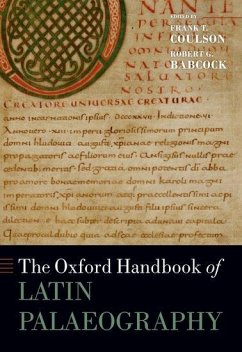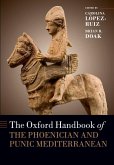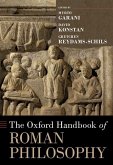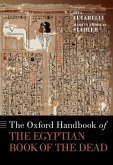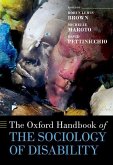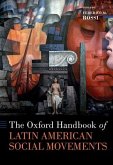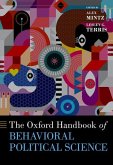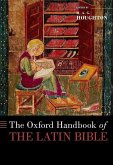- Broschiertes Buch
- Merkliste
- Auf die Merkliste
- Bewerten Bewerten
- Teilen
- Produkt teilen
- Produkterinnerung
- Produkterinnerung
The Oxford Handbook of Latin Palaeography provides a comprehensive overview of the development of Latin script from Antiquity to the Renaissance, codicology, and the cultural setting of the medieval manuscript. It will be an indispensable tool for all those interested in medieval book production.
Andere Kunden interessierten sich auch für
![The Oxford Handbook of the Phoenician and Punic Mediterranean The Oxford Handbook of the Phoenician and Punic Mediterranean]() The Oxford Handbook of the Phoenician and Punic Mediterranean57,99 €
The Oxford Handbook of the Phoenician and Punic Mediterranean57,99 €![The Oxford Handbook of Roman Philosophy The Oxford Handbook of Roman Philosophy]() The Oxford Handbook of Roman Philosophy222,99 €
The Oxford Handbook of Roman Philosophy222,99 €![The Oxford Handbook of the Egyptian Book of the Dead The Oxford Handbook of the Egyptian Book of the Dead]() The Oxford Handbook of the Egyptian Book of the Dead157,99 €
The Oxford Handbook of the Egyptian Book of the Dead157,99 €![The Oxford Handbook of the Sociology of Disability The Oxford Handbook of the Sociology of Disability]() The Oxford Handbook of the Sociology of Disability199,99 €
The Oxford Handbook of the Sociology of Disability199,99 €![The Oxford Handbook of Latin American Social Movements The Oxford Handbook of Latin American Social Movements]() Federico M RossiThe Oxford Handbook of Latin American Social Movements239,99 €
Federico M RossiThe Oxford Handbook of Latin American Social Movements239,99 €![The Oxford Handbook of Behavioral Political Science The Oxford Handbook of Behavioral Political Science]() The Oxford Handbook of Behavioral Political Science173,99 €
The Oxford Handbook of Behavioral Political Science173,99 €![The Oxford Handbook of the Latin Bible The Oxford Handbook of the Latin Bible]() The Oxford Handbook of the Latin Bible204,99 €
The Oxford Handbook of the Latin Bible204,99 €-
-
-
The Oxford Handbook of Latin Palaeography provides a comprehensive overview of the development of Latin script from Antiquity to the Renaissance, codicology, and the cultural setting of the medieval manuscript. It will be an indispensable tool for all those interested in medieval book production.
Hinweis: Dieser Artikel kann nur an eine deutsche Lieferadresse ausgeliefert werden.
Hinweis: Dieser Artikel kann nur an eine deutsche Lieferadresse ausgeliefert werden.
Produktdetails
- Produktdetails
- OXFORD HANDBOOKS SERIES
- Verlag: Oxford University Press Inc
- Seitenzahl: 1080
- Erscheinungstermin: 1. März 2023
- Englisch
- Abmessung: 249mm x 170mm x 38mm
- Gewicht: 1562g
- ISBN-13: 9780197689707
- ISBN-10: 0197689701
- Artikelnr.: 67326548
- Herstellerkennzeichnung
- Libri GmbH
- Europaallee 1
- 36244 Bad Hersfeld
- gpsr@libri.de
- OXFORD HANDBOOKS SERIES
- Verlag: Oxford University Press Inc
- Seitenzahl: 1080
- Erscheinungstermin: 1. März 2023
- Englisch
- Abmessung: 249mm x 170mm x 38mm
- Gewicht: 1562g
- ISBN-13: 9780197689707
- ISBN-10: 0197689701
- Artikelnr.: 67326548
- Herstellerkennzeichnung
- Libri GmbH
- Europaallee 1
- 36244 Bad Hersfeld
- gpsr@libri.de
Robert G. Babcock is Professor Emeritus of Classics at the University of North Carolina at Chapel Hill. He is a Fellow of the Flemish Royal Academy of Belgium, Korrespondierendes Mitglied der Zentraldirektion of Monumenta Germaniae Historica, and has held fellowships from the Alexander von Humboldt-Stiftung and the Belgian Institute for Advanced Studies. His publications focus on Latin manuscripts, Medieval Latin, and the transmission of Classical, Patristic, and Medieval Latin literature. Frank T. Coulson is Distinguished Professor of Classics in the Department of Classics at the Ohio State University. He has published widely on the reception of Ovid in the Medieval Ages and is currently finishing a volume for the Catalogus translationum et commentariorum on Ovid's Metamorphoses. He also serves as the Director of Palaeography for the Center for Epigraphical and Palaeographical Studies.
* Forward and Acknowledgements
* Introduction: Frank T. Coulson, Department of Classics, The Ohio
State University
* A. SCRIPT
* A.1 Organizing Script
* 1. Punctuation: Frank T. Coulson, Department of Classics, The Ohio
State University
* 2. Abbreviations: Olaf Pluta, Institut für Philosophie,
Ruhr-Universität Bochum
* 3. Numerals: Charles Burnett, Professor of the History of Islamic
Influences on Europe, Warburg Institute
* A.2 Greco-Roman Heritage
* 4. Old Roman Cursive: Teresa De Robertis, Dipartimento di Storia,
* Archeologia, Geografia, Arte, Spettacolo - Università di Firenze
(Translated from the Italian by Consuelo Dutschke)
* 5. New Roman Cursive: Teresa De Robertis, Dipartimento di Storia,
* Archeologia, Geografia, Arte, Spettacolo - Università di Firenze
(Translated from the Italian by Consuelo Dutschke)
* 6. Square and Rustic Capital: David Wright, The University of
California, Berkeley
* 7. Uncial: Robert G. Babcock, University of North Carolina at Chapel
Hill
* 8. Semi-Uncial: Robert G. Babcock, University of North Carolina at
Chapel Hill
* 9. Greek Scripts in Latin Manuscripts: Walter Berschin, Universität
Heidelberg
* A.3 Early Medieval Hands
* 10. Beneventan: Francis Newton, Professor of Latin Emeritus, Duke
University
* 11. Visigothic: Jesus Alturo i Perucho, Universitat Autonoma di
Barcelona
* 12. Luxeuil: Paolo Cherubini, Professore ordinario, Università degli
Studi di Milano - Bicocca
* 13. Merovingian Gaul: David Ganz, Visiting Professor of Palaeography,
The Medieval Institute, The University of Notre Dame
* 14. St. Gall and Alemannic: Anna A. Grotans, Department of Germanic
Languages and Literatures, The Ohio State University
* 15. Insular Script: Peter Stokes, King's College, University of
London
* A.4 Carolingian Minuscule
* 16. Carolingian Minuscule in France and Germany: David Ganz, Visiting
Professor of Palaeography, The Medieval Institute, The University of
Notre Dame
* 17. Early Carolingian Minuscule in Italy: Simona Gavinelli,
Università Cattolica del S. Cuore, Milano
* 18. Late Carolingian Minuscule in Italy: Mirella Ferrari, Università
Cattolica del S. Cuore, Milano
* 19. Tironian Notes: David Ganz, Visiting Professor of Palaeography,
The Medieval Institute, The University of Notre Dame
* A.5 Gothic
* 20. Nomenclature of Gothic Scripts: Albert Derolez Emeritus Professor
at the Free Universities of Brussels
* 21. French Gothic: Marie-Hélène Tesnière, Conservateur général au
département des Manuscrits de La Bibliothèque nationale de France
(Translated from the French by Frank T. Coulson)
* 22. Early English Gothic: Richard Gameson, Durham University
* 23. Later English Gothic: Pamela Robinson, University of London
* 24. German Gothic: Karl-Georg Pfaendtner, Bayerische
Staatsbibliothek, München
* 25. Early Italian Gothic: Stefano Zamponi, Università di Firenze
(Translated from the Italian by Consuelo Dutschke)
* 26. Late Italian Gothic: Stefano Zamponi, Università di Firenze
(Translated from the Italian by Consuelo Dutschke)
* 27. Late Dutch Gothic: J.P. Gumbert, Professor Emeritus, Leiden
University
* 28. Czech Republic: Hana Patkova, Charles University, Prague
* 29. Hungary and Slovakia: Juraj Sedivý, Comenius-University in
Bratislava / Faculty of Arts (Translated from the German by Anna A.
Grotans and Robert G. Babcock)
* 30. Interaction of Script and Print: Paul Needham, Scheide Librarian,
Princeton University
* A.6 Humanist
* 31. Origins of Humanist Script: Teresa De Robertis, Dipartimento di
Storia,
* Archeologia, Geografia, Arte, Spettacolo - Università di Firenze
(Translated from the Italian by Consuelo Dutschke)
* 32. Italian Humanist: Teresa De Robertis, Dipartimento di Storia,
Archeologia,
* Geografia, Arte, Spettacolo - Università di Firenze (Translated from
the Italian by Consuelo Dutschke)
* 33. Byzantium and the West: Marianne Pade, Director, Danish Academy
in Rome
* A.7
* 34. The Waning of Manuscript Production: B. Gregory Hays, Department
of Classics, University of Virginia
* B. MATERIAL EMBODIMENT AND TECHNIQUES
* 35. Stages of Manuscript Production: Lucien Reynhout, Curator at the
Department of Manuscripts Royal Library of Belgium, Brussels, Belgium
* 36. Stages in Diplomatic Production: Olivier Guyotjeannin, Directeur
d'études à l'École nationale des chartes, Paris (Translated from the
French by Robert G. Babcock and Frank T. Coulson)
* 37. Mise-en-page: Marie Hélène Tesnière, Conservateur général au
département des Manuscrits de La Bibliothèque nationale de France
(Translated from the French by Frank T. Coulson)
* 38. Format of Books: J.P. Gumbert, Professor Emeritus, Leiden
University
* 39. Format of Documents: Olivier Guyotjeannin, Directeur d'études à
l'École nationale des chartes (Paris) (Translated from the French by
Robert G. Babcock and Frank T. Coulson)
* 40. Quantitative Codicology: Ezio Ornato, CNRS, Paris (Translated
from the French by Robert G. Babcock and Frank T. Coulson)
* 41. Comparative Codicology: Malachi Beit-Arié, Professor Emeritus of
Codicology and Palaeography, The Hebrew University of Jerusalem
* 42. Pen Flourishing: Alison Stones, Professor Emeritus, University of
Pittsburgh
* C. CULTURAL SETTING
* 43. Orality and Visible Culture: Paul Saenger, Newberry Library,
Chicago
* 44. Who Were the Scribes: Alison Beach, Department of History, The
Ohio State University
* 45. Book Trade: Antiquity and the Early Middle Ages: Guglielmo
Cavallo, Accademia Nazionale dei Lincei, Roma
* 46. Book Trade: Central, High and Late Middle Ages: Kouky Fianu,
Université d'Ottawa/University of Ottawa
* D. SELECTED SCRIPTORIA AND LIBRARIES
* 47. An Overview: Donatella Nebbiai, Institut de recherche et
d'histoire des textes, Paris (Translated from the French by Frank T.
Coulson)
* 48. Lindisfarne: Michelle P. Brown FSA, Professor Emerita, SAS,
University of London
* 49. Northern Italy in the 7th and 8th Centuries: Paolo Cherubini,
Professore ordinario, Università degli Studi di Milano - Bicocca
* 50. Insular Script in its Cultural Context: Michelle P. Brown, FSA,
Professor Emerita, SAS, University of London
* 51. Montecassino: Francis Newton, Professor of Latin Emeritus, Duke
University
* 52. St. Gall: Anna A. Grotans, Department of Germanic Languages and
Literatures, The Ohio State University
* 53. University of Paris: Richard and Mary Rouse, University of
California, Los Angeles
* 54. Salisbury Cathedral Library: Teresa Webber, Trinity College,
Cambridge
* 55. Florence: Xavier van Binnebeke, Bodleian Library, Oxford
* E. VARIETIES OF BOOK USAGE
* 56. Books of Hours: Rowan Watson. Senior Curator, National Art
Library, Word and Image Department, Victoria and Albert Museum
* 57. Law: Susan L'Engle, Center for Medieval and Renaissance Studies,
St. Louis University
* 58. The Manuscript Miscellany: George Rigg, Professor Emeritus,
University of Toronto
* 59. Florilegia: Jacqueline Hamesse, Professor Emerita, L'Université
catholique de Louvain
* 60. Theological Texts: Lesley Smith, Professor of Medieval
Intellectual History, University of Oxford, Fellow in Politics and
Senior Tutor, Harris Manchester College
* 61. Gloss and Text: Greti Dinkova-Bruun, Pontifical Institute of
Mediaeval Studies, Toronto
* 62. Glossaries and Grammars: Patrizia Lendinara, Dipartimento Culture
e Società, Università di Palermo
* 63. The History of Manuscripts since 1500: B. Gregory Hays,
Department of Classics, University of Virginia
* 64. Manuscript Cataloguing: Consuelo Dutschke, Columbia University
* Introduction: Frank T. Coulson, Department of Classics, The Ohio
State University
* A. SCRIPT
* A.1 Organizing Script
* 1. Punctuation: Frank T. Coulson, Department of Classics, The Ohio
State University
* 2. Abbreviations: Olaf Pluta, Institut für Philosophie,
Ruhr-Universität Bochum
* 3. Numerals: Charles Burnett, Professor of the History of Islamic
Influences on Europe, Warburg Institute
* A.2 Greco-Roman Heritage
* 4. Old Roman Cursive: Teresa De Robertis, Dipartimento di Storia,
* Archeologia, Geografia, Arte, Spettacolo - Università di Firenze
(Translated from the Italian by Consuelo Dutschke)
* 5. New Roman Cursive: Teresa De Robertis, Dipartimento di Storia,
* Archeologia, Geografia, Arte, Spettacolo - Università di Firenze
(Translated from the Italian by Consuelo Dutschke)
* 6. Square and Rustic Capital: David Wright, The University of
California, Berkeley
* 7. Uncial: Robert G. Babcock, University of North Carolina at Chapel
Hill
* 8. Semi-Uncial: Robert G. Babcock, University of North Carolina at
Chapel Hill
* 9. Greek Scripts in Latin Manuscripts: Walter Berschin, Universität
Heidelberg
* A.3 Early Medieval Hands
* 10. Beneventan: Francis Newton, Professor of Latin Emeritus, Duke
University
* 11. Visigothic: Jesus Alturo i Perucho, Universitat Autonoma di
Barcelona
* 12. Luxeuil: Paolo Cherubini, Professore ordinario, Università degli
Studi di Milano - Bicocca
* 13. Merovingian Gaul: David Ganz, Visiting Professor of Palaeography,
The Medieval Institute, The University of Notre Dame
* 14. St. Gall and Alemannic: Anna A. Grotans, Department of Germanic
Languages and Literatures, The Ohio State University
* 15. Insular Script: Peter Stokes, King's College, University of
London
* A.4 Carolingian Minuscule
* 16. Carolingian Minuscule in France and Germany: David Ganz, Visiting
Professor of Palaeography, The Medieval Institute, The University of
Notre Dame
* 17. Early Carolingian Minuscule in Italy: Simona Gavinelli,
Università Cattolica del S. Cuore, Milano
* 18. Late Carolingian Minuscule in Italy: Mirella Ferrari, Università
Cattolica del S. Cuore, Milano
* 19. Tironian Notes: David Ganz, Visiting Professor of Palaeography,
The Medieval Institute, The University of Notre Dame
* A.5 Gothic
* 20. Nomenclature of Gothic Scripts: Albert Derolez Emeritus Professor
at the Free Universities of Brussels
* 21. French Gothic: Marie-Hélène Tesnière, Conservateur général au
département des Manuscrits de La Bibliothèque nationale de France
(Translated from the French by Frank T. Coulson)
* 22. Early English Gothic: Richard Gameson, Durham University
* 23. Later English Gothic: Pamela Robinson, University of London
* 24. German Gothic: Karl-Georg Pfaendtner, Bayerische
Staatsbibliothek, München
* 25. Early Italian Gothic: Stefano Zamponi, Università di Firenze
(Translated from the Italian by Consuelo Dutschke)
* 26. Late Italian Gothic: Stefano Zamponi, Università di Firenze
(Translated from the Italian by Consuelo Dutschke)
* 27. Late Dutch Gothic: J.P. Gumbert, Professor Emeritus, Leiden
University
* 28. Czech Republic: Hana Patkova, Charles University, Prague
* 29. Hungary and Slovakia: Juraj Sedivý, Comenius-University in
Bratislava / Faculty of Arts (Translated from the German by Anna A.
Grotans and Robert G. Babcock)
* 30. Interaction of Script and Print: Paul Needham, Scheide Librarian,
Princeton University
* A.6 Humanist
* 31. Origins of Humanist Script: Teresa De Robertis, Dipartimento di
Storia,
* Archeologia, Geografia, Arte, Spettacolo - Università di Firenze
(Translated from the Italian by Consuelo Dutschke)
* 32. Italian Humanist: Teresa De Robertis, Dipartimento di Storia,
Archeologia,
* Geografia, Arte, Spettacolo - Università di Firenze (Translated from
the Italian by Consuelo Dutschke)
* 33. Byzantium and the West: Marianne Pade, Director, Danish Academy
in Rome
* A.7
* 34. The Waning of Manuscript Production: B. Gregory Hays, Department
of Classics, University of Virginia
* B. MATERIAL EMBODIMENT AND TECHNIQUES
* 35. Stages of Manuscript Production: Lucien Reynhout, Curator at the
Department of Manuscripts Royal Library of Belgium, Brussels, Belgium
* 36. Stages in Diplomatic Production: Olivier Guyotjeannin, Directeur
d'études à l'École nationale des chartes, Paris (Translated from the
French by Robert G. Babcock and Frank T. Coulson)
* 37. Mise-en-page: Marie Hélène Tesnière, Conservateur général au
département des Manuscrits de La Bibliothèque nationale de France
(Translated from the French by Frank T. Coulson)
* 38. Format of Books: J.P. Gumbert, Professor Emeritus, Leiden
University
* 39. Format of Documents: Olivier Guyotjeannin, Directeur d'études à
l'École nationale des chartes (Paris) (Translated from the French by
Robert G. Babcock and Frank T. Coulson)
* 40. Quantitative Codicology: Ezio Ornato, CNRS, Paris (Translated
from the French by Robert G. Babcock and Frank T. Coulson)
* 41. Comparative Codicology: Malachi Beit-Arié, Professor Emeritus of
Codicology and Palaeography, The Hebrew University of Jerusalem
* 42. Pen Flourishing: Alison Stones, Professor Emeritus, University of
Pittsburgh
* C. CULTURAL SETTING
* 43. Orality and Visible Culture: Paul Saenger, Newberry Library,
Chicago
* 44. Who Were the Scribes: Alison Beach, Department of History, The
Ohio State University
* 45. Book Trade: Antiquity and the Early Middle Ages: Guglielmo
Cavallo, Accademia Nazionale dei Lincei, Roma
* 46. Book Trade: Central, High and Late Middle Ages: Kouky Fianu,
Université d'Ottawa/University of Ottawa
* D. SELECTED SCRIPTORIA AND LIBRARIES
* 47. An Overview: Donatella Nebbiai, Institut de recherche et
d'histoire des textes, Paris (Translated from the French by Frank T.
Coulson)
* 48. Lindisfarne: Michelle P. Brown FSA, Professor Emerita, SAS,
University of London
* 49. Northern Italy in the 7th and 8th Centuries: Paolo Cherubini,
Professore ordinario, Università degli Studi di Milano - Bicocca
* 50. Insular Script in its Cultural Context: Michelle P. Brown, FSA,
Professor Emerita, SAS, University of London
* 51. Montecassino: Francis Newton, Professor of Latin Emeritus, Duke
University
* 52. St. Gall: Anna A. Grotans, Department of Germanic Languages and
Literatures, The Ohio State University
* 53. University of Paris: Richard and Mary Rouse, University of
California, Los Angeles
* 54. Salisbury Cathedral Library: Teresa Webber, Trinity College,
Cambridge
* 55. Florence: Xavier van Binnebeke, Bodleian Library, Oxford
* E. VARIETIES OF BOOK USAGE
* 56. Books of Hours: Rowan Watson. Senior Curator, National Art
Library, Word and Image Department, Victoria and Albert Museum
* 57. Law: Susan L'Engle, Center for Medieval and Renaissance Studies,
St. Louis University
* 58. The Manuscript Miscellany: George Rigg, Professor Emeritus,
University of Toronto
* 59. Florilegia: Jacqueline Hamesse, Professor Emerita, L'Université
catholique de Louvain
* 60. Theological Texts: Lesley Smith, Professor of Medieval
Intellectual History, University of Oxford, Fellow in Politics and
Senior Tutor, Harris Manchester College
* 61. Gloss and Text: Greti Dinkova-Bruun, Pontifical Institute of
Mediaeval Studies, Toronto
* 62. Glossaries and Grammars: Patrizia Lendinara, Dipartimento Culture
e Società, Università di Palermo
* 63. The History of Manuscripts since 1500: B. Gregory Hays,
Department of Classics, University of Virginia
* 64. Manuscript Cataloguing: Consuelo Dutschke, Columbia University
* Forward and Acknowledgements
* Introduction: Frank T. Coulson, Department of Classics, The Ohio
State University
* A. SCRIPT
* A.1 Organizing Script
* 1. Punctuation: Frank T. Coulson, Department of Classics, The Ohio
State University
* 2. Abbreviations: Olaf Pluta, Institut für Philosophie,
Ruhr-Universität Bochum
* 3. Numerals: Charles Burnett, Professor of the History of Islamic
Influences on Europe, Warburg Institute
* A.2 Greco-Roman Heritage
* 4. Old Roman Cursive: Teresa De Robertis, Dipartimento di Storia,
* Archeologia, Geografia, Arte, Spettacolo - Università di Firenze
(Translated from the Italian by Consuelo Dutschke)
* 5. New Roman Cursive: Teresa De Robertis, Dipartimento di Storia,
* Archeologia, Geografia, Arte, Spettacolo - Università di Firenze
(Translated from the Italian by Consuelo Dutschke)
* 6. Square and Rustic Capital: David Wright, The University of
California, Berkeley
* 7. Uncial: Robert G. Babcock, University of North Carolina at Chapel
Hill
* 8. Semi-Uncial: Robert G. Babcock, University of North Carolina at
Chapel Hill
* 9. Greek Scripts in Latin Manuscripts: Walter Berschin, Universität
Heidelberg
* A.3 Early Medieval Hands
* 10. Beneventan: Francis Newton, Professor of Latin Emeritus, Duke
University
* 11. Visigothic: Jesus Alturo i Perucho, Universitat Autonoma di
Barcelona
* 12. Luxeuil: Paolo Cherubini, Professore ordinario, Università degli
Studi di Milano - Bicocca
* 13. Merovingian Gaul: David Ganz, Visiting Professor of Palaeography,
The Medieval Institute, The University of Notre Dame
* 14. St. Gall and Alemannic: Anna A. Grotans, Department of Germanic
Languages and Literatures, The Ohio State University
* 15. Insular Script: Peter Stokes, King's College, University of
London
* A.4 Carolingian Minuscule
* 16. Carolingian Minuscule in France and Germany: David Ganz, Visiting
Professor of Palaeography, The Medieval Institute, The University of
Notre Dame
* 17. Early Carolingian Minuscule in Italy: Simona Gavinelli,
Università Cattolica del S. Cuore, Milano
* 18. Late Carolingian Minuscule in Italy: Mirella Ferrari, Università
Cattolica del S. Cuore, Milano
* 19. Tironian Notes: David Ganz, Visiting Professor of Palaeography,
The Medieval Institute, The University of Notre Dame
* A.5 Gothic
* 20. Nomenclature of Gothic Scripts: Albert Derolez Emeritus Professor
at the Free Universities of Brussels
* 21. French Gothic: Marie-Hélène Tesnière, Conservateur général au
département des Manuscrits de La Bibliothèque nationale de France
(Translated from the French by Frank T. Coulson)
* 22. Early English Gothic: Richard Gameson, Durham University
* 23. Later English Gothic: Pamela Robinson, University of London
* 24. German Gothic: Karl-Georg Pfaendtner, Bayerische
Staatsbibliothek, München
* 25. Early Italian Gothic: Stefano Zamponi, Università di Firenze
(Translated from the Italian by Consuelo Dutschke)
* 26. Late Italian Gothic: Stefano Zamponi, Università di Firenze
(Translated from the Italian by Consuelo Dutschke)
* 27. Late Dutch Gothic: J.P. Gumbert, Professor Emeritus, Leiden
University
* 28. Czech Republic: Hana Patkova, Charles University, Prague
* 29. Hungary and Slovakia: Juraj Sedivý, Comenius-University in
Bratislava / Faculty of Arts (Translated from the German by Anna A.
Grotans and Robert G. Babcock)
* 30. Interaction of Script and Print: Paul Needham, Scheide Librarian,
Princeton University
* A.6 Humanist
* 31. Origins of Humanist Script: Teresa De Robertis, Dipartimento di
Storia,
* Archeologia, Geografia, Arte, Spettacolo - Università di Firenze
(Translated from the Italian by Consuelo Dutschke)
* 32. Italian Humanist: Teresa De Robertis, Dipartimento di Storia,
Archeologia,
* Geografia, Arte, Spettacolo - Università di Firenze (Translated from
the Italian by Consuelo Dutschke)
* 33. Byzantium and the West: Marianne Pade, Director, Danish Academy
in Rome
* A.7
* 34. The Waning of Manuscript Production: B. Gregory Hays, Department
of Classics, University of Virginia
* B. MATERIAL EMBODIMENT AND TECHNIQUES
* 35. Stages of Manuscript Production: Lucien Reynhout, Curator at the
Department of Manuscripts Royal Library of Belgium, Brussels, Belgium
* 36. Stages in Diplomatic Production: Olivier Guyotjeannin, Directeur
d'études à l'École nationale des chartes, Paris (Translated from the
French by Robert G. Babcock and Frank T. Coulson)
* 37. Mise-en-page: Marie Hélène Tesnière, Conservateur général au
département des Manuscrits de La Bibliothèque nationale de France
(Translated from the French by Frank T. Coulson)
* 38. Format of Books: J.P. Gumbert, Professor Emeritus, Leiden
University
* 39. Format of Documents: Olivier Guyotjeannin, Directeur d'études à
l'École nationale des chartes (Paris) (Translated from the French by
Robert G. Babcock and Frank T. Coulson)
* 40. Quantitative Codicology: Ezio Ornato, CNRS, Paris (Translated
from the French by Robert G. Babcock and Frank T. Coulson)
* 41. Comparative Codicology: Malachi Beit-Arié, Professor Emeritus of
Codicology and Palaeography, The Hebrew University of Jerusalem
* 42. Pen Flourishing: Alison Stones, Professor Emeritus, University of
Pittsburgh
* C. CULTURAL SETTING
* 43. Orality and Visible Culture: Paul Saenger, Newberry Library,
Chicago
* 44. Who Were the Scribes: Alison Beach, Department of History, The
Ohio State University
* 45. Book Trade: Antiquity and the Early Middle Ages: Guglielmo
Cavallo, Accademia Nazionale dei Lincei, Roma
* 46. Book Trade: Central, High and Late Middle Ages: Kouky Fianu,
Université d'Ottawa/University of Ottawa
* D. SELECTED SCRIPTORIA AND LIBRARIES
* 47. An Overview: Donatella Nebbiai, Institut de recherche et
d'histoire des textes, Paris (Translated from the French by Frank T.
Coulson)
* 48. Lindisfarne: Michelle P. Brown FSA, Professor Emerita, SAS,
University of London
* 49. Northern Italy in the 7th and 8th Centuries: Paolo Cherubini,
Professore ordinario, Università degli Studi di Milano - Bicocca
* 50. Insular Script in its Cultural Context: Michelle P. Brown, FSA,
Professor Emerita, SAS, University of London
* 51. Montecassino: Francis Newton, Professor of Latin Emeritus, Duke
University
* 52. St. Gall: Anna A. Grotans, Department of Germanic Languages and
Literatures, The Ohio State University
* 53. University of Paris: Richard and Mary Rouse, University of
California, Los Angeles
* 54. Salisbury Cathedral Library: Teresa Webber, Trinity College,
Cambridge
* 55. Florence: Xavier van Binnebeke, Bodleian Library, Oxford
* E. VARIETIES OF BOOK USAGE
* 56. Books of Hours: Rowan Watson. Senior Curator, National Art
Library, Word and Image Department, Victoria and Albert Museum
* 57. Law: Susan L'Engle, Center for Medieval and Renaissance Studies,
St. Louis University
* 58. The Manuscript Miscellany: George Rigg, Professor Emeritus,
University of Toronto
* 59. Florilegia: Jacqueline Hamesse, Professor Emerita, L'Université
catholique de Louvain
* 60. Theological Texts: Lesley Smith, Professor of Medieval
Intellectual History, University of Oxford, Fellow in Politics and
Senior Tutor, Harris Manchester College
* 61. Gloss and Text: Greti Dinkova-Bruun, Pontifical Institute of
Mediaeval Studies, Toronto
* 62. Glossaries and Grammars: Patrizia Lendinara, Dipartimento Culture
e Società, Università di Palermo
* 63. The History of Manuscripts since 1500: B. Gregory Hays,
Department of Classics, University of Virginia
* 64. Manuscript Cataloguing: Consuelo Dutschke, Columbia University
* Introduction: Frank T. Coulson, Department of Classics, The Ohio
State University
* A. SCRIPT
* A.1 Organizing Script
* 1. Punctuation: Frank T. Coulson, Department of Classics, The Ohio
State University
* 2. Abbreviations: Olaf Pluta, Institut für Philosophie,
Ruhr-Universität Bochum
* 3. Numerals: Charles Burnett, Professor of the History of Islamic
Influences on Europe, Warburg Institute
* A.2 Greco-Roman Heritage
* 4. Old Roman Cursive: Teresa De Robertis, Dipartimento di Storia,
* Archeologia, Geografia, Arte, Spettacolo - Università di Firenze
(Translated from the Italian by Consuelo Dutschke)
* 5. New Roman Cursive: Teresa De Robertis, Dipartimento di Storia,
* Archeologia, Geografia, Arte, Spettacolo - Università di Firenze
(Translated from the Italian by Consuelo Dutschke)
* 6. Square and Rustic Capital: David Wright, The University of
California, Berkeley
* 7. Uncial: Robert G. Babcock, University of North Carolina at Chapel
Hill
* 8. Semi-Uncial: Robert G. Babcock, University of North Carolina at
Chapel Hill
* 9. Greek Scripts in Latin Manuscripts: Walter Berschin, Universität
Heidelberg
* A.3 Early Medieval Hands
* 10. Beneventan: Francis Newton, Professor of Latin Emeritus, Duke
University
* 11. Visigothic: Jesus Alturo i Perucho, Universitat Autonoma di
Barcelona
* 12. Luxeuil: Paolo Cherubini, Professore ordinario, Università degli
Studi di Milano - Bicocca
* 13. Merovingian Gaul: David Ganz, Visiting Professor of Palaeography,
The Medieval Institute, The University of Notre Dame
* 14. St. Gall and Alemannic: Anna A. Grotans, Department of Germanic
Languages and Literatures, The Ohio State University
* 15. Insular Script: Peter Stokes, King's College, University of
London
* A.4 Carolingian Minuscule
* 16. Carolingian Minuscule in France and Germany: David Ganz, Visiting
Professor of Palaeography, The Medieval Institute, The University of
Notre Dame
* 17. Early Carolingian Minuscule in Italy: Simona Gavinelli,
Università Cattolica del S. Cuore, Milano
* 18. Late Carolingian Minuscule in Italy: Mirella Ferrari, Università
Cattolica del S. Cuore, Milano
* 19. Tironian Notes: David Ganz, Visiting Professor of Palaeography,
The Medieval Institute, The University of Notre Dame
* A.5 Gothic
* 20. Nomenclature of Gothic Scripts: Albert Derolez Emeritus Professor
at the Free Universities of Brussels
* 21. French Gothic: Marie-Hélène Tesnière, Conservateur général au
département des Manuscrits de La Bibliothèque nationale de France
(Translated from the French by Frank T. Coulson)
* 22. Early English Gothic: Richard Gameson, Durham University
* 23. Later English Gothic: Pamela Robinson, University of London
* 24. German Gothic: Karl-Georg Pfaendtner, Bayerische
Staatsbibliothek, München
* 25. Early Italian Gothic: Stefano Zamponi, Università di Firenze
(Translated from the Italian by Consuelo Dutschke)
* 26. Late Italian Gothic: Stefano Zamponi, Università di Firenze
(Translated from the Italian by Consuelo Dutschke)
* 27. Late Dutch Gothic: J.P. Gumbert, Professor Emeritus, Leiden
University
* 28. Czech Republic: Hana Patkova, Charles University, Prague
* 29. Hungary and Slovakia: Juraj Sedivý, Comenius-University in
Bratislava / Faculty of Arts (Translated from the German by Anna A.
Grotans and Robert G. Babcock)
* 30. Interaction of Script and Print: Paul Needham, Scheide Librarian,
Princeton University
* A.6 Humanist
* 31. Origins of Humanist Script: Teresa De Robertis, Dipartimento di
Storia,
* Archeologia, Geografia, Arte, Spettacolo - Università di Firenze
(Translated from the Italian by Consuelo Dutschke)
* 32. Italian Humanist: Teresa De Robertis, Dipartimento di Storia,
Archeologia,
* Geografia, Arte, Spettacolo - Università di Firenze (Translated from
the Italian by Consuelo Dutschke)
* 33. Byzantium and the West: Marianne Pade, Director, Danish Academy
in Rome
* A.7
* 34. The Waning of Manuscript Production: B. Gregory Hays, Department
of Classics, University of Virginia
* B. MATERIAL EMBODIMENT AND TECHNIQUES
* 35. Stages of Manuscript Production: Lucien Reynhout, Curator at the
Department of Manuscripts Royal Library of Belgium, Brussels, Belgium
* 36. Stages in Diplomatic Production: Olivier Guyotjeannin, Directeur
d'études à l'École nationale des chartes, Paris (Translated from the
French by Robert G. Babcock and Frank T. Coulson)
* 37. Mise-en-page: Marie Hélène Tesnière, Conservateur général au
département des Manuscrits de La Bibliothèque nationale de France
(Translated from the French by Frank T. Coulson)
* 38. Format of Books: J.P. Gumbert, Professor Emeritus, Leiden
University
* 39. Format of Documents: Olivier Guyotjeannin, Directeur d'études à
l'École nationale des chartes (Paris) (Translated from the French by
Robert G. Babcock and Frank T. Coulson)
* 40. Quantitative Codicology: Ezio Ornato, CNRS, Paris (Translated
from the French by Robert G. Babcock and Frank T. Coulson)
* 41. Comparative Codicology: Malachi Beit-Arié, Professor Emeritus of
Codicology and Palaeography, The Hebrew University of Jerusalem
* 42. Pen Flourishing: Alison Stones, Professor Emeritus, University of
Pittsburgh
* C. CULTURAL SETTING
* 43. Orality and Visible Culture: Paul Saenger, Newberry Library,
Chicago
* 44. Who Were the Scribes: Alison Beach, Department of History, The
Ohio State University
* 45. Book Trade: Antiquity and the Early Middle Ages: Guglielmo
Cavallo, Accademia Nazionale dei Lincei, Roma
* 46. Book Trade: Central, High and Late Middle Ages: Kouky Fianu,
Université d'Ottawa/University of Ottawa
* D. SELECTED SCRIPTORIA AND LIBRARIES
* 47. An Overview: Donatella Nebbiai, Institut de recherche et
d'histoire des textes, Paris (Translated from the French by Frank T.
Coulson)
* 48. Lindisfarne: Michelle P. Brown FSA, Professor Emerita, SAS,
University of London
* 49. Northern Italy in the 7th and 8th Centuries: Paolo Cherubini,
Professore ordinario, Università degli Studi di Milano - Bicocca
* 50. Insular Script in its Cultural Context: Michelle P. Brown, FSA,
Professor Emerita, SAS, University of London
* 51. Montecassino: Francis Newton, Professor of Latin Emeritus, Duke
University
* 52. St. Gall: Anna A. Grotans, Department of Germanic Languages and
Literatures, The Ohio State University
* 53. University of Paris: Richard and Mary Rouse, University of
California, Los Angeles
* 54. Salisbury Cathedral Library: Teresa Webber, Trinity College,
Cambridge
* 55. Florence: Xavier van Binnebeke, Bodleian Library, Oxford
* E. VARIETIES OF BOOK USAGE
* 56. Books of Hours: Rowan Watson. Senior Curator, National Art
Library, Word and Image Department, Victoria and Albert Museum
* 57. Law: Susan L'Engle, Center for Medieval and Renaissance Studies,
St. Louis University
* 58. The Manuscript Miscellany: George Rigg, Professor Emeritus,
University of Toronto
* 59. Florilegia: Jacqueline Hamesse, Professor Emerita, L'Université
catholique de Louvain
* 60. Theological Texts: Lesley Smith, Professor of Medieval
Intellectual History, University of Oxford, Fellow in Politics and
Senior Tutor, Harris Manchester College
* 61. Gloss and Text: Greti Dinkova-Bruun, Pontifical Institute of
Mediaeval Studies, Toronto
* 62. Glossaries and Grammars: Patrizia Lendinara, Dipartimento Culture
e Società, Università di Palermo
* 63. The History of Manuscripts since 1500: B. Gregory Hays,
Department of Classics, University of Virginia
* 64. Manuscript Cataloguing: Consuelo Dutschke, Columbia University

